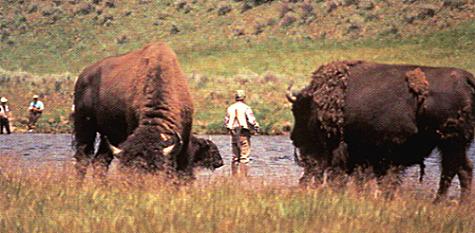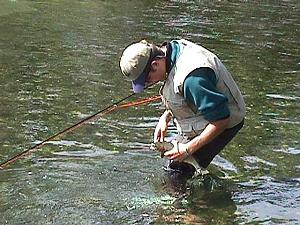- You are here:
- FAOL Home >>
- Articles >>
- Ladyfisher
 |
from Deanna Travis FlyAnglers Online Publisher & Owner |
COST PLUS?
The Upper Yellowstone River in Yellowstone National Park (YNP) has probably been on the list of ‘best places’ for fly fisherman since the first articles appeared in Fly Fisherman magazine back in the 1960s. Everyone who made it to the West in the golden days before Whirling Disease had the magic experience of catching seemingly endless fish. Not just fish, but beautiful golden Yellowstone cutthroats in almost unbelievably numbers. It was possible, with not too much work, to hook and land a fish a minute. And I have the photos to prove it. Probably most of the photographs you’ve ever seen of the Yellowstone River in the park were taken at Buffalo Ford – and usually with a buffalo or two in the picture.

Everyone who could would meet at what was then called Buffalo Ford on opening day the 15th of July. (The rest of the Park opens Memorial Day weekend.) It was show and tell for adults, and tailgate picnics before anyone called it tailgating. My late husband JC and I were there for many of those openings after we made the big move to Montana. It was a very big deal.
Even after we moved to the west coast, we still loved coming back and fishing the park. The ‘fish in’ back in 1998 was just a holiday for us, a bit of a celebration since we were just coming up on the first anniversary of Fly Anglers OnLine. We wanted to get some serious fishing time in and fishing on the saltwater just isn’t the same as trout fishing.
We had mentioned we were headed to the park for ten days or so and we got a couple of phone calls and emails – to the effect of where are you going, where are you going to fish, and can we come? In the end, Jeff Fields from Georgia flew up to Bozeman and rented a car to join us, and a former student and son from Seattle and his other younger son drove out from Washington to fish with us. In fact, here is a small excerpt from my column of August 3, 1998:
“A highlight for JC and I was fishing with Mike and his two sons. Mike and his older son Aaron were former students of our casting school. The younger son John, only 11 is a tenacious, patient, enthusiastic fly fisher. His willingness to be taught and to put what he was learning into practice was great fun to watch. Aaron has become a good caster. Given a few more healthy fish to cast to, he will be pushing his dad. That's what fly fishing used to be - a family passing on knowledge, skills and appreciation of the out-of-doors.”

Mike really needed that time away from his job as well. He was captain of the SWAT team in Tacoma at the time. He has since left that job, became a private investigator and mostly works doing background checks for a big computer manufacturing company in the Portland Oregon area. Gratefully he got out without being injured and the best news, both of the boys are still into fly fishing!
I had the joy of teaching the boys how to spot the fish and where to put a fly on Buffalo Ford, just upstream where the now closed back channel flows back into the main stream around the little island. The cutthroats were lined up line pigs at a trough and as soon as we picked off the lead fish the next one in line would take its place. The boys had a great time and so did their teacher.
Unfortunately we have lost that wonderful fishery. There are still fish there, but in nowhere near the kinds of numbers we were just talking about. The question is; “What happened?”
Whirling disease took its toll and while it was my understanding that it was only the rainbow trout which were affected, I’m told the cutts were hit as well. Then there is the problem of the lake trout in Yellowstone Lake. I don’t know the exact year, but at one time there was a hatchery in YNP. Lake trout were raised and stocked in Hart and Lewis Lakes. We know that for sure. Who planted the ‘lakers’ in Yellowstone Lake has become a mystery? (It is a mystery because no one wants to admit that it’s likely that the Park Service actually did it). No matter, they have n tried to eliminate them, but they are still there and eating the smaller cutthroats.
Add to that the big white pelicans which eat their weight in fish every day and wow, the numbers of fish in the Yellowstone River dropped a lot. Who would have thought? Obviously no one. Actually some years ago there was a method of controlling the pelican numbers by a spring egg walk, where park employees were paid to remove/destroy eggs from the pelican nests. That was stopped when some environmentalists complained, so now we have too many pelicans and those numbers will continue to increase until lack of food or disease kills them off.
The fabulous fishery is somewhat rebounding, whirling disease seems to have done whatever it is going to do, and while the numbers probably will never be what they were in the 70’s and 80’s, they are good enough to again list the upper Yellowstone as an important destination.
The bad news is that once a place gets a reputation for not having fish it takes years for the bad reputation to go away. People don’t want to come back to fish a place they got skunked, and the guides aren’t going to take their clients there either. They don’t want unhappy clients – doesn’t make for very good tips.
So what’s the real cost of losing a world-class fishery? Can you ever really get it back? Will the anglers ever come back?
Only time will tell. And besides, they even changed the name of the place. I’ll bet you can’t even find Buffalo Ford on a map these days.
| Editor's Note |
|---|
| The decline of the fishery in the upper Yellowstone River within Yellowstone National Park is a documented fact; however, there are likely a number of reasons for this decline. In the natural world nothing remains the same, including fisheries, and the best advice that I can give is to enjoy them while you can. |